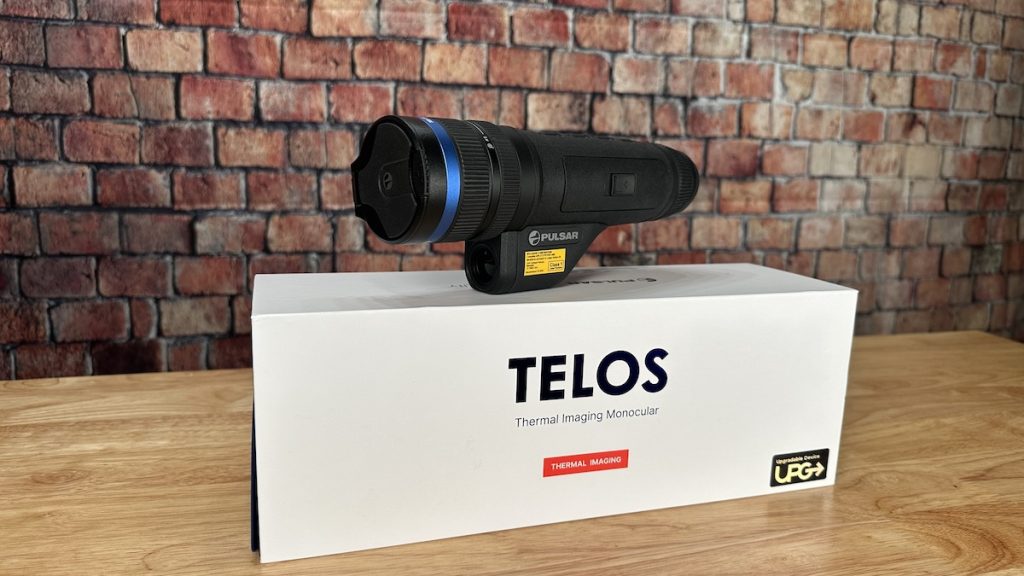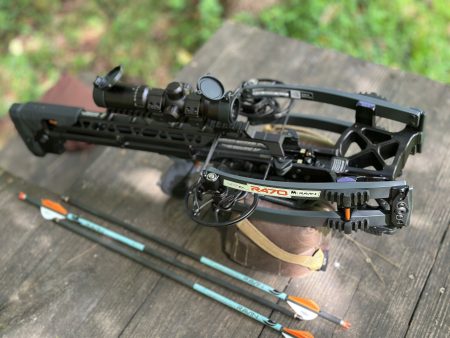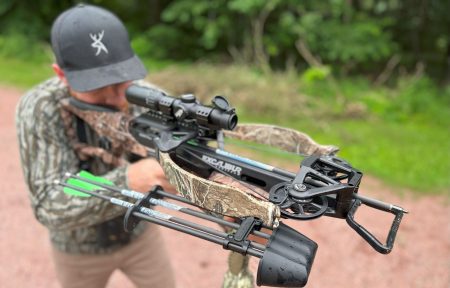Night hunting just got a major upgrade with the Pulsar Telos LRF XP50. Designed for hunters and outdoor enthusiasts, this premium thermal monocular combines cutting-edge technology with exceptional performance. Whether you’re chasing hogs in the dark, scanning fields for coyotes, or exploring the outdoors, the Pulsar Telos LRF XP50 delivers unmatched image clarity, an integrated laser rangefinder, and customizable features. With a wide range of applications, from wildlife observation to rescue operations, this versatile device is a must-have for anyone seeking precision and reliability in the field.
Method of Testing a Pulsar Telos LRF XP50
Over the past several years, I have been fortunate enough to have the opportunity to participate in some wild hog-hunting adventures and a little bit of coyote hunting – both of which are primarily done at night. Most of our time is spent chasing hogs in box blinds. Maybe I’m strange, but I find it quite enjoyable to sit in a blind, in the dark, enjoying the quiet and calm while expectantly waiting for a group of feeding pigs to interrupt my peace.
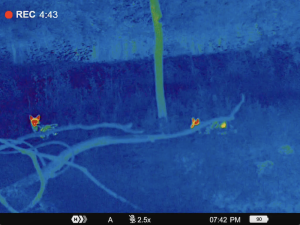
Like most people, my first attempt at pig hunting involved using a green flashlight attached to my rifle. I sat patiently, waiting to hear something that sounded like grunting pigs fumbling through the woods. Then, at the first noise that resembled a medium-sized animal, I would point my gun in that direction, turn on the light, hope it was a pig, and really hope it didn’t run off.
That whole thing never worked very well for me. So, I upgraded and bought a lower-end, beginner monocular that made it possible to (sort of) see what was lurking in the woods at night. The picture was not very clear, but through it, I could tell the difference between a deer, a possum/raccoon, or a pig. When that wasn’t good enough any more, I made the upgrade to a digital night vision scope, which made a huge difference. With that scope, I could quickly and easily identify the various nocturnal creatures rustling through the leaves with pretty good clarity.
But, I’m a sucker for technology. Digital night vision is great and serves my purposes quite well, but when I had the chance to look through a few thermal monoculars at various trade shows and other events, I knew I had to test one out for myself. I was able to borrow the Telos LRF XP50 from Pulsar and put it through its paces. So, what makes it so great?
Pulsar Telos LRF XP50 – PRODUCT DESCRIPTION
The Telos LRF XP50 is one of the higher-end thermal monoculars made by Pulsar. Pulsar has been very well known for the quality of its digital day/night vision and thermal imaging optics for years. And, even though this article discusses the Telos LRF XP50 in regards to hunting at night, thermal monoculars such as this one have a wide variety of applications.
The Telos LRF XP50 IS great for spotting wildlife at night, but it is equally as effective during the day. Thermal optics like this one use high-sensitivity sensors to generate an image based on – you guessed it – temperatures. More specifically, they detect the differences in temperatures. So even during the day, when infrared illumination such as that used with night vision optics is ineffective, objects and animals are still generating or reflecting heat – making them detectable (and identifiable).
This is the reason thermal monoculars have so many uses. Some people use them to help track an animal they have shot because of the temperature differences between the animal’s blood and the ground, leaves, or trees where he or she may have run.
We actually used this monocular a couple of weeks ago when leaving our blind after dark to check our surroundings before heading out. It was nice to be able to scan the field around us and make sure we weren’t going to spook any deer on our way out. We actually saw a couple of coyotes, too.
Monoculars like the Telos LRF XP50 can also be used for surveillance in security situations. They are also quite useful in rescue and recovery missions. With all those uses and its many features, maybe a Pulsar Telos LRF XP50 should be next on your list.
KEY FEATURES/BENEFITS
Thermal Sensor
The Thermal Sensor is one of the most critical components of any thermal imaging optic. The better the sensor, the clearer the objects in your field of view. The Telos LRF XP50 uses a <18 mK NETD sensor, which may not mean much to you.
NETD stands for Noise Equivalent Temperature Difference, which measures the smallest temperature difference the sensor can detect. The lower the number, the more sensitive the sensor, which means the image will be clearer. Detecting very minor temperature differences is especially important in conditions such as rain or fog, where the field can somewhat get “washed out.” Anything under 25 is considered excellent, so the Telos LRF XP50 has the potential for some pretty impressive images.
I was very impressed by this monocular one day when I was watching my cat in our backyard. She was about 30 yards away, and I could see fur on her where the temperatures varied between hairs.
Resolution
Resolution is, of course, another major factor in the clarity of the images this monocular will generate.
Just like a computer, phone, or television, resolution can vary widely. With a microbolometer resolution of 640×480 pix, the Telos LRF XP50 is on the higher end of the quality spectrum when it comes to thermal imaging devices. Plus, the display resolution is 1024×768 (better quality than 720p) which creates a clear, easy-to-view image. And, with a pixel pitch of 17µm (again, lower is better), the clarity of the image you see should be even greater.
User Mode that Allows for Better Clarity
The Telos LRF XP50 can be put in what they call “User Mode.” This means that you can adjust your brightness, contrast, etc., and when User Mode is selected, the optic will automatically maintain those settings. So, if you are watching over a field for a few hours, you will not have to reset those parameters each time. This is especially nice because making those adjustments can be a little tricky when trying to hold the monocular and see what is down range.
Detection Range
Because of that 640×480@17µm thermal imaging sensor, we discussed, combined with the fact that the Telos LRF XP50 has an F50/1.0 objective lens, this optic is effective for very long ranges. According to the Pulsar website, an object that is just shy of 6 feet tall should be detectable over 1,900 yards away.
That detection range could tremendously benefit finding games when hunting over large fields or flatlands. But the implications for surveillance, rescue, and recovery could also be pretty impactful.
Manual Zoom and Focus
At the front of the Telos LRF XP50 is a manual, rotational zoom. At its widest, the magnification is set at 2.5x, so it is obviously not designed for viewing objects that are close. This monocular is capable of zooming out to 10x magnification. Just in front of the manual zoom ring is the manual focus ring. I like that it is not an automatic focus because with the potential of having so many objects, trees, animals, etc., between you and what you actually want to see, the focus ring allows you to choose what to focus on.
Eight Color Palettes
The Telos LRF XP50 has eight color palettes to choose from. With so many options, you should be able to find one that meets your needs. When scanning for wildlife or other people, I’ve found I prefer the Rainbow palette. This is the palette you may be most familiar with because it is often used in movies due to the stark contrasts in temperatures it shows. I like it better for finding animals because of that contrast, but also because it – well, it just looks cooler.
Some of the palette options, such as red monochrome, sepia, and violet are designed to be a bit gentler on the eyes. Any of these options would be good if you are going to be doing some long-term scanning or observing as they put less strain on your eyes. The display brightness can also be adjusted to help with this as well.
Integrated Laser Rangefinder (LRF)
If you’ve been wondering what the LRF in Telos LRF XP50 means, here it is. This thermal optic has an integrated laser rangefinder, which is especially helpful when using this monocular for hunting purposes.
The guesstimating range is much easier during the day when landmarks and changes in terrain are easily seen. All of that is out the window if you’re hunting at night. So, having a thermal laser rangefinder to determine the exact distance of your target and make appropriate doping changes to your rifle’s scope is critical.
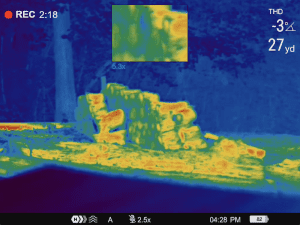
According to Pulsar, this rangefinder is accurate up to 1,000 meters. Plus, you can also choose to show the angle of your target in the display, so accurate ballistic calculations should be much easier.
Picture in Picture Mode
The Telos LRF XP50 allows you to use Picture-In-Picture (PIP) mode. When this is turned on, a smaller “screen” appears at the top of your viewing area that is zoomed into what is in the center reticle.
This feature is extremely helpful when scanning a large block of wood or a field. When the optic is in PIP mode, the zoom function applies only the smaller picture. This affords the user the opportunity to keep the main screen zoomed out so you can still scan the entire field, while being able to zoom in on one specific object/animal. The PIP feature is nice because you can zoom in closer to make an identification but still be able to see what is going on around it, in case something else is nearby.
Rechargeable Battery
The Telos LRF XP50 comes with a rechargeable LPS Lithium-Ion battery pack. The battery has a 6400mAh capacity and is advertised to have a run time of 8.5 hours. It can be recharged by plugging in the battery, plugging in the monocular when the battery is in it, or using a wireless charging pad. Extra batteries can also be purchased if you think you may need more than 8.5 hours.
On Board Internal Memory
One of my favorite things about the Telos LRF XP50 is that it has 64GB of on board memory. It can record 1024×768 video and also take photos that will be stored directly on the device. These days we all seem to want footage of everything, and the internal memory makes it very easy to do. I can’t tell you how many times I’ve headed to the woods with my digital night vision scope for a hunting adventure only to find I forgot to put the micro SD card back in – no more!
Of course, you still have to remember to download your footage from the device and clear the memory so you’ll have space next time. Pulsar has also made that process fairly easy as well. One way to download footage is to plug in the USB-C cable to the device and then plug that into your computer. Since that is the same USB-C port you can use to charge it, you choose if you want the connection to charge the device or download from it. Then from the menu screen, you simply format the device once all your videos are downloaded.
WiFi/Bluetooth (Stream App)
The other way to download your videos and photos is through the Stream Vision 2 app. The Telos LRF XP50 also has onboard WiFi that allows you to connect your phone directly to the optic. From there you can see what is stored in the onboard memory and choose what to download to your phone.
But, that’s not all. The Stream Vision 2 app also has a lot of really cool features as well. When connected to the Telos LRF XP50, your phone can serve as the viewfinder. This feature can be great for sharing what you’re seeing through the viewfinder with your friends who are with you. You could also mount the monocular to a tripod and not have to look directly into the optic.
From the Stream Vision 2 app, you can also change your color palette and amplification setting. You can switch between video and photo mode, and you can even control recording and photo-taking from your phone. All of the settings you can change through the optic can be adjusted through the app: brightness, contrast, PIP. and more.
Pulsar Telos LRF XP50 – SPECIFICATIONS
| Housing | Rubber Armored Reinforced Plastic |
| Length x Height | 9.37”x3.5” (tallest point) |
| Weight | 1lb 9oz (with the battery) |
| Objective Lens | F50/1.0 |
| Eye Relief | ~ ½” |
| Field of view (degrees/m @100m) | 12.4×9.3/21.8×16.3 |
| Magnification | 2.5-10x |
| Operating Temperature Range | -13℉ – 104℉ |
| Waterproof Rating | IPX7 waterproof (protection from heavy rainfall, snow, etc.) |
WHY WOULD YOU BUY?
The Pulsar Telos LRF XP50 is a fantastic thermal monocular. If you have the opportunity to do a good bit of hog or predator hunting, and your state allows for the use of thermal optics, then this is one you should definitely take a look at. This optic is feature-rich and has a great deal of adjustability. With the color palette options, image clarity, onboard memory, and rechargeable battery, the Telos could be an excellent option for spotting and keeping an eye on wildlife for your next hunting endeavor.
With all the benefits, there are a couple of drawbacks as well.
PROS
- Very high quality images! The high-end thermal sensor and resolution provide excellent picture quality
- Multiple choices for thermal color palette allow for a very customizable optic that meets your needs.
- It has an integrated laser rangefinder that can be extremely helpful for finding proper aim points when night hunting.
- 64GB of internal on board memory – no additional memory cards required.
- Rechargeable Li-Ion battery provides up to 8.5 hours of run time.
- IPX7 waterproof
CONS
- This thermal monocular is not cheap. With the LRF function, MSRP on this one is right at $4,000.00
- Several states have regulations against using thermal optics while hunting, so make sure you check your state’s regs before using.
FINAL THOUGHTS
So far I’ve been pretty impressed with the Telos LRF XP50. This thermal monocular takes the guessing game out of finding your target animals at night. Instead of hoping the noise you heard was a pig that doesn’t run off when you shine your green light on it, you can know before you even make a move. Scanning an open field to decide your next steps would be so much easier with this optic.
The $4,000 price tag is no joke. If you don’t have the opportunity to do a lot of hunting at night, then you may want to seek out other, less expensive options, including digital night vision viewers. Of course, it seems in the world of thermal optics, the price tag is primarily dependent on the sensor and resolution. Therefore, less expensive optics are likely going to have lower quality sensors, producing lower quality images. So, the decision is what do you need to achieve your goals?
Per our affiliate disclosure, we may earn revenue from the products available on this page. To learn more about how we test gear, click here.

